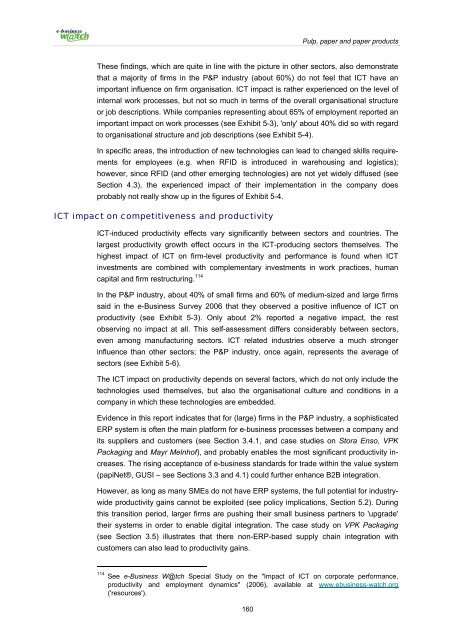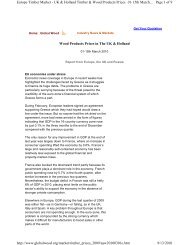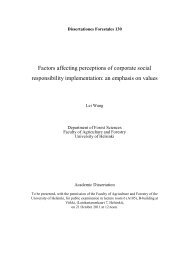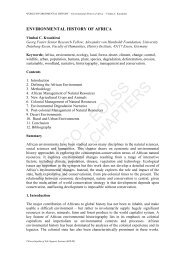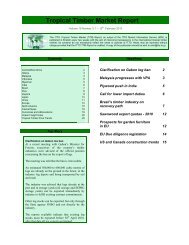ICT and e-Business in the Pulp, Paper and Paper ... - empirica
ICT and e-Business in the Pulp, Paper and Paper ... - empirica
ICT and e-Business in the Pulp, Paper and Paper ... - empirica
Create successful ePaper yourself
Turn your PDF publications into a flip-book with our unique Google optimized e-Paper software.
<strong>Pulp</strong>, paper <strong>and</strong> paper products<br />
These f<strong>in</strong>d<strong>in</strong>gs, which are quite <strong>in</strong> l<strong>in</strong>e with <strong>the</strong> picture <strong>in</strong> o<strong>the</strong>r sectors, also demonstrate<br />
that a majority of firms <strong>in</strong> <strong>the</strong> P&P <strong>in</strong>dustry (about 60%) do not feel that <strong>ICT</strong> have an<br />
important <strong>in</strong>fluence on firm organisation. <strong>ICT</strong> impact is ra<strong>the</strong>r experienced on <strong>the</strong> level of<br />
<strong>in</strong>ternal work processes, but not so much <strong>in</strong> terms of <strong>the</strong> overall organisational structure<br />
or job descriptions. While companies represent<strong>in</strong>g about 65% of employment reported an<br />
important impact on work processes (see Exhibit 5-3), 'only' about 40% did so with regard<br />
to organisational structure <strong>and</strong> job descriptions (see Exhibit 5-4).<br />
In specific areas, <strong>the</strong> <strong>in</strong>troduction of new technologies can lead to changed skills requirements<br />
for employees (e.g. when RFID is <strong>in</strong>troduced <strong>in</strong> warehous<strong>in</strong>g <strong>and</strong> logistics);<br />
however, s<strong>in</strong>ce RFID (<strong>and</strong> o<strong>the</strong>r emerg<strong>in</strong>g technologies) are not yet widely diffused (see<br />
Section 4.3), <strong>the</strong> experienced impact of <strong>the</strong>ir implementation <strong>in</strong> <strong>the</strong> company does<br />
probably not really show up <strong>in</strong> <strong>the</strong> figures of Exhibit 5-4.<br />
<strong>ICT</strong> impact on competitiveness <strong>and</strong> productivity<br />
<strong>ICT</strong>-<strong>in</strong>duced productivity effects vary significantly between sectors <strong>and</strong> countries. The<br />
largest productivity growth effect occurs <strong>in</strong> <strong>the</strong> <strong>ICT</strong>-produc<strong>in</strong>g sectors <strong>the</strong>mselves. The<br />
highest impact of <strong>ICT</strong> on firm-level productivity <strong>and</strong> performance is found when <strong>ICT</strong><br />
<strong>in</strong>vestments are comb<strong>in</strong>ed with complementary <strong>in</strong>vestments <strong>in</strong> work practices, human<br />
capital <strong>and</strong> firm restructur<strong>in</strong>g. 114<br />
In <strong>the</strong> P&P <strong>in</strong>dustry, about 40% of small firms <strong>and</strong> 60% of medium-sized <strong>and</strong> large firms<br />
said <strong>in</strong> <strong>the</strong> e-<strong>Bus<strong>in</strong>ess</strong> Survey 2006 that <strong>the</strong>y observed a positive <strong>in</strong>fluence of <strong>ICT</strong> on<br />
productivity (see Exhibit 5-3). Only about 2% reported a negative impact, <strong>the</strong> rest<br />
observ<strong>in</strong>g no impact at all. This self-assessment differs considerably between sectors,<br />
even among manufactur<strong>in</strong>g sectors. <strong>ICT</strong> related <strong>in</strong>dustries observe a much stronger<br />
<strong>in</strong>fluence than o<strong>the</strong>r sectors; <strong>the</strong> P&P <strong>in</strong>dustry, once aga<strong>in</strong>, represents <strong>the</strong> average of<br />
sectors (see Exhibit 5-6).<br />
The <strong>ICT</strong> impact on productivity depends on several factors, which do not only <strong>in</strong>clude <strong>the</strong><br />
technologies used <strong>the</strong>mselves, but also <strong>the</strong> organisational culture <strong>and</strong> conditions <strong>in</strong> a<br />
company <strong>in</strong> which <strong>the</strong>se technologies are embedded.<br />
Evidence <strong>in</strong> this report <strong>in</strong>dicates that for (large) firms <strong>in</strong> <strong>the</strong> P&P <strong>in</strong>dustry, a sophisticated<br />
ERP system is often <strong>the</strong> ma<strong>in</strong> platform for e-bus<strong>in</strong>ess processes between a company <strong>and</strong><br />
its suppliers <strong>and</strong> customers (see Section 3.4.1, <strong>and</strong> case studies on Stora Enso, VPK<br />
Packag<strong>in</strong>g <strong>and</strong> Mayr Melnhof), <strong>and</strong> probably enables <strong>the</strong> most significant productivity <strong>in</strong>creases.<br />
The ris<strong>in</strong>g acceptance of e-bus<strong>in</strong>ess st<strong>and</strong>ards for trade with<strong>in</strong> <strong>the</strong> value system<br />
(papiNet®, GUSI – see Sections 3.3 <strong>and</strong> 4.1) could fur<strong>the</strong>r enhance B2B <strong>in</strong>tegration.<br />
However, as long as many SMEs do not have ERP systems, <strong>the</strong> full potential for <strong>in</strong>dustrywide<br />
productivity ga<strong>in</strong>s cannot be exploited (see policy implications, Section 5.2). Dur<strong>in</strong>g<br />
this transition period, larger firms are push<strong>in</strong>g <strong>the</strong>ir small bus<strong>in</strong>ess partners to 'upgrade'<br />
<strong>the</strong>ir systems <strong>in</strong> order to enable digital <strong>in</strong>tegration. The case study on VPK Packag<strong>in</strong>g<br />
(see Section 3.5) illustrates that <strong>the</strong>re non-ERP-based supply cha<strong>in</strong> <strong>in</strong>tegration with<br />
customers can also lead to productivity ga<strong>in</strong>s.<br />
114 See e-<strong>Bus<strong>in</strong>ess</strong> W@tch Special Study on <strong>the</strong> "Impact of <strong>ICT</strong> on corporate performance,<br />
productivity <strong>and</strong> employment dynamics" (2006), available at www.ebus<strong>in</strong>ess-watch.org<br />
('resources').<br />
160


